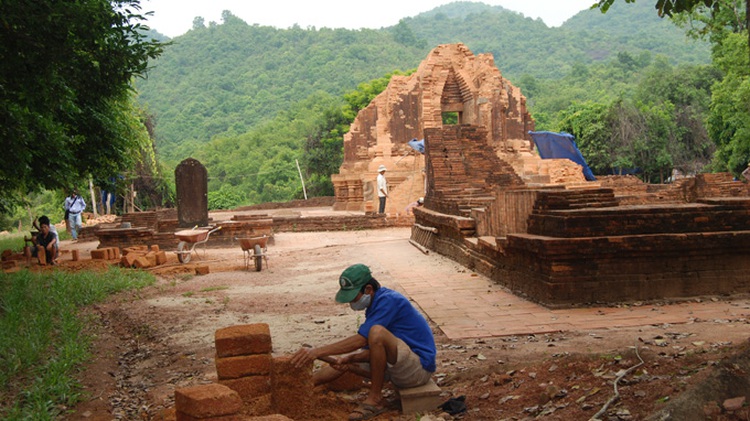
Three Italian experts who worked for over ten years on the recently completed restoration of the G Cham tower group, one of the key groups within the UNESCO-recognized My Son relic site, stressed that they always made sure the revamp didn’t spoil or change the original structures.
One day before the restored towers were opened to the public on June 22, Dr. Mauro Cucarzi, Dr. Patrizia Zolese and senior preservation architect Mara Landoni shared their experiences during their work.
The restoration process was initiated by Richard Engelhardt, UNESCO Regional Advisor for Culture in Asia and the Pacific, who suggested doing something meaningful for the My Son relic. Not long after that, the Italian government began providing considerable funding for the project, which gathered some 100 local and foreign experts, since 2007.
According to Dr. Zolese, the team chose to restore the G Towers as they were untouched by the Polish-Vietnamese team which previously did restoration work at My Son.
“The tower cluster, which didn’t suffer severe wartime bombing, still has an intact base, and some of the bodies are intact as well. Also, the cluster didn’t receive as much attention from French experts in the 20th century as the A, B, C and F clusters. So we chose to apply the latest archeological restoration techniques and turn the group into a model, which the next Cham towers to be restored will be based on,” she elaborated.
“The layers after layers convey fascinating details on the towers and their builders. The G Tower cluster, built by Champa King Jaya Harivarman in the later half of the 12th century, is unique for the three stepped entrances, instead of one like in the other tower clusters, and the laterite encrusted around the towers, which has never been found in other tower clusters.”
Cham towers are known for their unique type of brick, which adheres to one another without mortar, and on which intricate, tiny patterns can be engraved without breaking apart.
Dr. Zolese said that she excavated hundreds of decorative details from the total area of 2,000 m2 and painstakingly studied them over three years.
Her team also analyzed the physical and biochemical properties of the bricks before finally coming up with a formula to produce a type of brick which most closely resembles the original and doesn't clash with the remaining (original) bricks on the towers.
Landoni added that, based on previous studies, the team conducted intensive research on the “dau rai” plants, which are abundant around the My Son relic. This is similar to the unique adhesive that was used in the towers.
“We found striking resemblances between the chemical found in “dau rai” plants and the adhesive used in the Cham towers. To our fascination, the chemical is also found inside the bricks,” she added.
However, she confirmed that her team didn’t find the adhesive which the ancient Cham people used to build their towers, as some newspapers recently claimed.
“By applying archeological restoration techniques and adopting international standards in the process, we tried to minimize the use of new materials and retain as much as possible of the time-honored relic,” she stressed.
“Other restoration experts may criticize our methods in one way or another, but we have to ‘rescue’ the relic, or else it’ll be in ruins in one to five years’ time. We respect the relic’s history, for instance, we won’t restore part of a tower which has collapsed,” noted Dr. Cucarzi.
However, she stressed that the project isn’t only about restoring the towers and exhibiting the excavated artifacts.
“Through the project, we’ve trained a number of skilled workers in relic restoration. They’ve made notable progress, as when they started as local farmers they didn’t have any idea about restoration, and now they have turned into highly skilled workers in this technically demanding task,” she added.
According to Dr. Cucarzi, the Italian government will continue sponsoring the project, with work still underway on the restoration of the G4 tower. After that, the team will move on to the L tower cluster, which will require at least 15 workers to restore it.
| The G Tower cluster, comprising five towers, is one of the key clusters at the My Son relic site. This is the first time the cluster has been restored. Restoration of the cluster began in 1997. |


Max: 1500 characters
There are no comments yet. Be the first to comment.